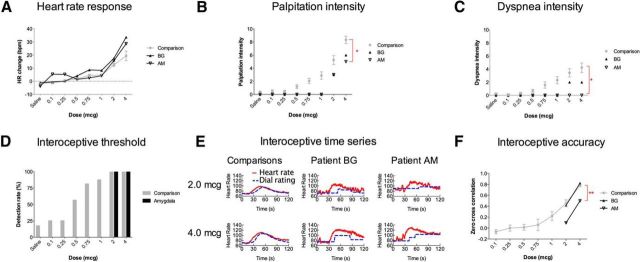Figure 4.
Cardiorespiratory interoception in humans with bilateral amygdala lesions and healthy comparisons. A, Heart rate response to isoproterenol. Both patients displayed higher heart rate responses than comparisons, but these differences were not statistically significant. B, Palpitation intensity. Both patients reported lower palpitation intensities. These differences were significant for patient A.M. at the highest dose (4 μg, *p = 0.047). C, Dyspnea intensity. Both patients reported lower dyspnea intensities. These differences were marginally significant for patient A.M. at the highest dose (4μg, *p = 0.051). Notably, patient A.M. did not report any dyspnea across all doses, whereas all of the healthy comparisons reported increased dyspnea (i.e., rated as ≥1 of 10) at the highest two doses. D, Cardiorespiratory detection thresholds. Both patients detected changes only at the highest two doses (2 and 4 μg). E, Time course of heart rate (red) and dial ratings (blue) at the two highest doses (2 and 4 μg). Participants rated the overall intensity of heartbeat and respiratory sensations on a moment-to-moment basis using a dial. Patient A.M. demonstrated abnormal detection latencies and prolonged dial turns. F, Cardiorespiratory accuracy, measured via zero-order cross-correlation between heart rate changes and dial ratings. Patient A.M. demonstrated significantly poorer cardiorespiratory accuracy at the highest dose (4 μg, **p = 0.006). Error bars indicate SEM.

